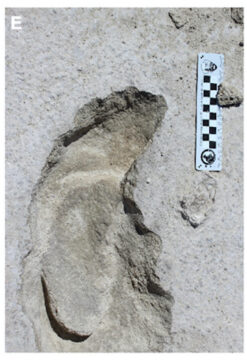by Dilip D’Souza

Many years ago, I spent a lazy evening in the Parque Balvanero Vargas in Limón, Costa Rica. I use that word deliberately, because I was lulled into laziness by the animal I was watching. In a diary I kept about that trip are these lines: “A small sloth is hanging upside down and munching on the leaves, a cat-sized light brown mat of hair. After a while he turns and comes near enough to touch. That appears to startle him, though his surprise is as slow and measured as his movements.”
That charming experience came back to mind some years after that, when I read a paper about giant sloths. A team of scientists examined a series of fossil sloth footprints in the White Sands National Monument in New Mexico. They dated these prints to 11,000 years ago, that dating a feat in itself for various reasons. But their further inferences from these ancient impressions in the clay were even more impressive, and their paper tells that story. (David Bustos et al, Footprints preserve terminal Pleistocene hunt? Human-sloth interactions in North America, ScienceAdvances, 25 April 2018.)
Among the prints the sloths left were several human ones. Examining them closely, the scientists concluded that these humans were probably stalking and harrying a giant sloth; that the animal eventually stopped to face its tormentors; that the humans may have then run up to throw spears at the sloth. That is, these tracks in White Sands may be telling the story of a long-ago hunt. And if that’s so, and if humans did regularly hunt those animals, they may be part of why giant sloths are now extinct.
All fascinating, yet the reason all this came back to mind this week is still another paper. Or two, actually.
Some background: In the 1970s, RM Alexander studied fossil “trackways”, like the one in White Sands. He measured stride lengths – the distance between successive impressions of the same foot – of the animals that had left footprints. The question he wanted to answer was, how fast did these ancient animals move? More to the point, could he estimate that speed from just this fossil record of footprints? Read more »
